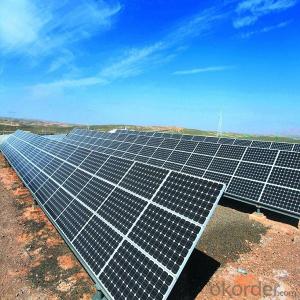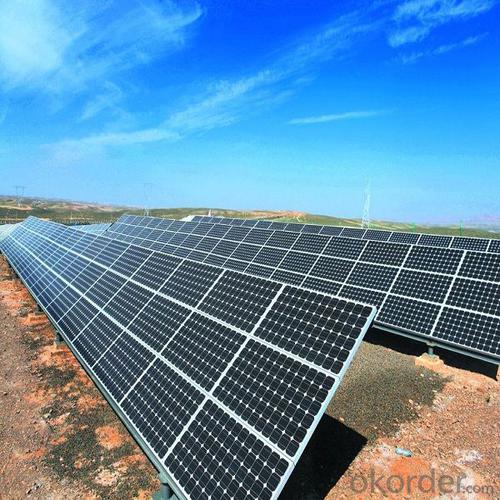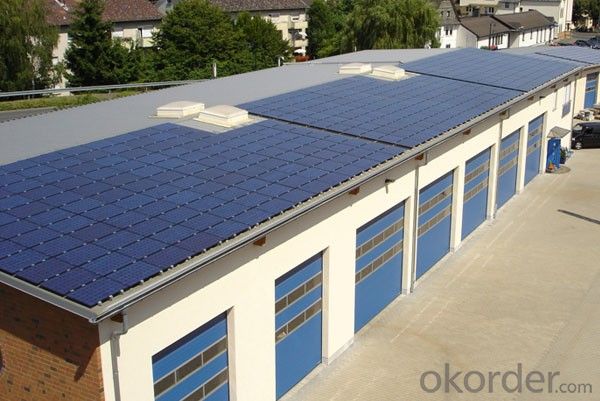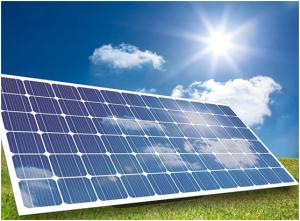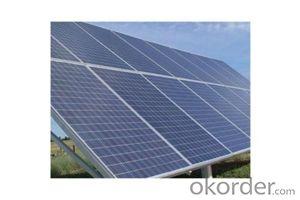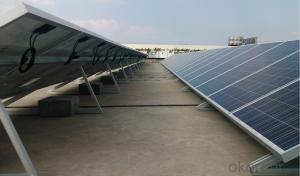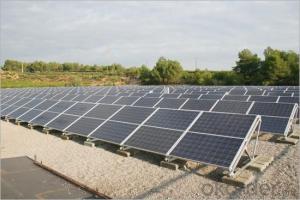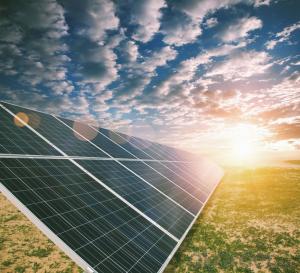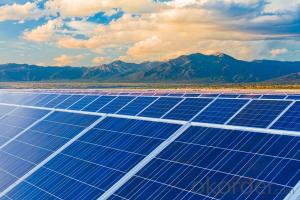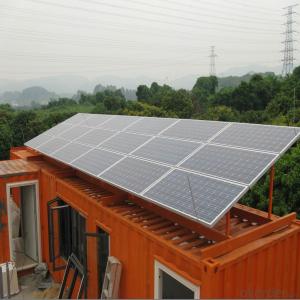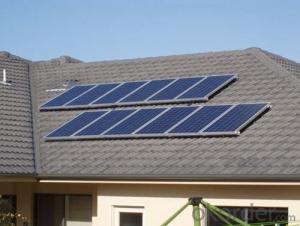Phono Solar Panels - High-Efficiency 260W Polycrystalline Solar Panel
- Loading Port:
- Shanghai
- Payment Terms:
- TT OR LC
- Min Order Qty:
- 100 watt
- Supply Capability:
- 10000 watt/month
OKorder Service Pledge
OKorder Financial Service
You Might Also Like
Specification
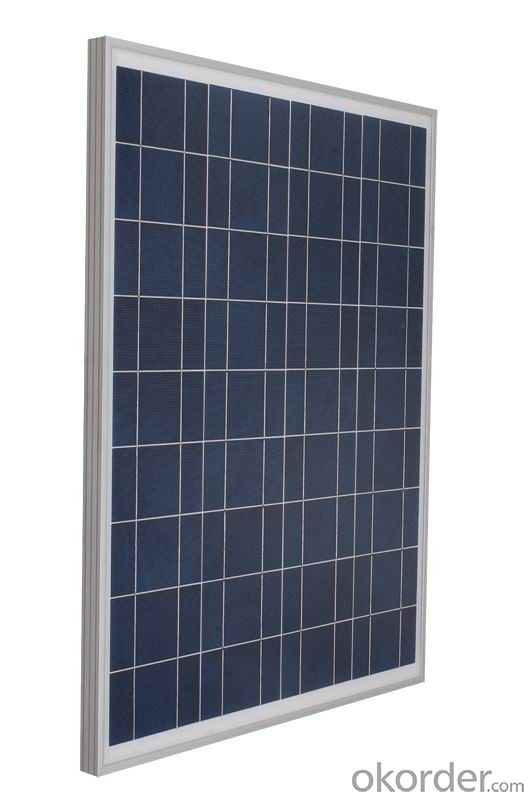
Product Description
260W Poly Crystalline Solar Panel
Product Highlights:
1. Guarantee positive power tolerance (0~+3%)
2. Module can bear snow loads up to 5400Pa and wind loads up to 2400pa
3. High performance under low light conditions (cloudy days, mornings and evenings)
4. Certified by Europe standards of TUV, IEC, CE and British MCS and AUS CEC
5. OEM/ODM available
Specs
| Electrical Characteristics | |
| Maximum Power [Pmax] | 260W |
| Power Tolerance | +/-3% |
| Maximum Power Voltage [Vmp] | 30.5V |
| Maximum Power Current [Imp] | 8.53A |
| Short-Circuit Current [Isc] | 8.81A |
| Open-Circuit Voltage [Voc] | 37.7V |
| Module Efficiency | 15.98% |
| Max. System Voltage | 1000VDC |
| Cell Size and Series | Poly 156*156 60pcs (6*10) |
| Temperature Coefficient of Pmax | - 0.47% / º C |
| Temperature Coefficient of Voc | - 0.33% / º C |
| Temperature Coefficient of Isc | 0.05% / º C |
| Mechanical Characteristics | |
| Dimension (mm) | 1640*992*40 |
| Frame | Anodized Aluminium Alloy |
| Glass | 3.2mm,High Transmission,Tempered Glass |
| Junction box & Cable | IP65 Rated weatherproof connectors Cable: TUV 1x4.0mm2 / UL12AWG,Length:900mm |
| Weight | 19.0Kgs |
Industry-leading Warranty:
Warranty on material and workmanship: 10 years
Guaranteed output of 90% after 12 years and 80% after 25 years.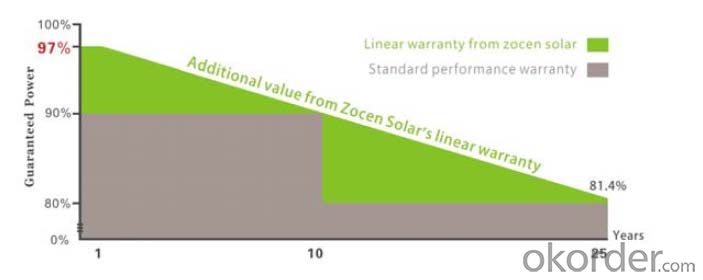
- Q: In terms of efficiency and cost, what is the best solar panel. I am limited in the number of panels I can put up (probably 6-8) so they must be efficient, but cost is important also.What about these panels that can collect a wider range of light frequency?
- your initial outlay for a solar panel is very large in terms of output.......somewhere around $4 a watt......ie you want a panel that will run a 00 watt lightbulb? $400.00 please. enough panels to collect enough energy to recharge a battery bank to run the house overnight? well, I've been doing a lot of research for my condo project in St Thomas and it comes out to 0-20,000 US $ for a bedroom apartment. Now, after about ten years you have made your investemnt back.... and there are a lot of government rebate programs that lower the cost.. what I have found is solar is nice, but depending on how far north you live you may only have 4 usable hours of light a day. you may very well be better with a wind generator.wind blows all the time after all...Bergy and SouthWest Windpower make two good small home units...start there
- Q: the solar panel works with LEDs, small bulbs,etc but neve with any dcmotor. Please help. I have a science exhibition.
- BECAUSE IT COULD ENOUGH SUPPORT ENOUGH CURRENT, VOLTAGE DROPS DOWN NEAR V WHILE OVERLOADED WITH MOTOR. BUY A VERY LARGE SIZE SOLAR CELL WILL FIX IT.
- Q: Any recommendations for companies? Any things to look out for?
- There okorder / Why pay thousands of dollars for solar energy ($27,000 average cost) when you can build your own solar panel system for just a fraction of the retail cost. You can build a single solar panel or you can build an entire array of panels to power your whole house. Some people are saving 50% on their power bill, some people are reducing their bill to nothing. But what’s most impressive is that just by following these instructions some are even making the power company pay them!
- Q: I am in the market for buying a home. There is one for salke that actually has solar panels on top. How are they used? Do you need to pay for gas and electric still. Does it really light up the house and keep it warm. WHat about the AC keeping hte house cool in the summer does it work for that too? Please explain in solar for dummy terms. I haveno clue about solar panels other thatn the fact that it needs sunlight to run.
- well see a house can totally depend on solar energy (solar panels) but u will still have to pay the electricity bill because if the solar panels dont work u will have a back up,eg like in winters when it snows , it can cover the solar panels or during the winter seson when it is cloudy or snowing the sunlight can not reach the solar panels because of which they can not charge. but on the other hand because of the solar panels the bills will be decresed and u will have to pay only a small amount. I HOPE I WAS HELP FULL
- Q: Can solar panels be used for powering a farm or agricultural operation?
- Yes, solar panels can definitely be used to power a farm or agricultural operation. Solar energy can be harnessed and converted into electricity to meet various energy needs in the agricultural sector, such as powering irrigation systems, pumps, lighting, and other machinery. By utilizing solar panels, farmers can reduce their reliance on fossil fuels, lower energy costs, and contribute to a more sustainable and environmentally friendly operation.
- Q: Photo-Voltaic solar panels are very expensive. Most of a home's energy needs are for heating water, heating and air-conditioning. All of these can be met with thermal solar collectors which are much less expensive. The thermal solar panels would heat water stored in a hot water tank which then can be used as hot water, to heat the home, or as the heat source to a Lithium Bromide Absorption chiller to air-condition a home. With the base line needs met without expensive panels and without inefficient energy conversions, only a small Photo-Voltaic array would be needed for the remaining power needs and since those needs are variable, there would still be power to sell to the grid.
- I agree with you John and for the same reason already put forth as a negative. Solar thermal is a more mature technology. This is the reason why I spent so much of the last winter studying it. I can be reasonably sure that what I learn will not be obsolete tomorrow with a new technological breakthrough. I built a solar addition/greenhouse to personally study the effects. So solar thermal panels are not the only way to go. With respect to electrical production. I have seen parabolic reflectors coupled to stirling engines and solar thermal trough heaters used to supplement steam generation for alternatively gas fired steam / electrical generation plants. On a trip to China over 4 years ago I noticed solar hot water vacuum tube collectors being sold in their local hardware and big box style stores. These were gravity fed package units intended to have the tank on the roof with a supplemental electric backup. The vacuum tube collectors seem to be one of the latest innovations in this technology. Using phase change materials temperatures in these panels can be produced in excess of 400 deg F. and they are useful in colder temps and on cloudy days. While they are still costly for many applications, I have been discussing the use of vacuum tube collectors with the owner of a laundrymat. Solar thermal will not pay back as well as conservation in many cases of older construction, but it currently seems better than photovoltaic panels. Solar thermal requires more understanding of systems and relative efficiencies. In one way solar thermal is more like the electric car while the internal combusion engine is like photovoltaic. The idea of producing electricity from the sun is a sexier idea. It is also more in line with our paridigm of: just producing lots of energy and to H with any conservation efforts. For that reason it seems to get more press.
- Q: what parts and tool do i need to build and connect a solar electric panel to my home
- Solar energy is very expensive. Or I should say, solar panels are expensive, because once you install them the power is free. A typical residential solar power system that supplies around a kilowatt of power at best conditions (noon, sunny day) will cost about $0,000. This includes the solar panel, the inverter (converts DC into AC), the cabling, but not installation (that would probably run you another $2000). One kilowatt is not that much electricity. It would run one microwave oven, or one hair dryer, or 0 light bulbs, and nothing else. Most houses use 3 times that at peak hours. So you would still likely get some power off the grid at peak time, and other times you can sell it back to make a little money. The good news is that solar panels are getting cheaper. They are around $5 per watt now, and are projected to drop to half that in the next decade. At some point, it will reach the sweet spot that makes solar an attractive alternative to grid power and more people will jump on board. There are some tax incentives too, but more would certainly help.
- Q: Can solar panels be installed on public transportation systems?
- Yes, solar panels can be installed on public transportation systems. In fact, many cities around the world are increasingly integrating solar panels onto buses, trams, and trains to harness clean energy and reduce carbon emissions. These panels can be installed on the roofs or sides of vehicles, enabling them to generate electricity and contribute to the power needs of the transportation systems.
- Q: How do solar panels affect the overall sustainability of a building?
- Solar panels can significantly improve the overall sustainability of a building by generating clean and renewable energy. By harnessing the power of the sun, solar panels reduce the reliance on fossil fuels and minimize greenhouse gas emissions, helping to combat climate change. Additionally, solar panels can lower energy costs, enhance energy independence, and contribute to a more resilient and eco-friendly infrastructure.
- Q: How do solar panels affect the property's overall sustainability?
- Solar panels can significantly enhance a property's overall sustainability by harnessing renewable energy from the sun. They reduce dependence on fossil fuels, decrease carbon emissions, and contribute to energy independence. Additionally, solar panels can generate surplus electricity that can be sold back to the grid, further enhancing the property's sustainability and potentially providing financial benefits.
Send your message to us
Phono Solar Panels - High-Efficiency 260W Polycrystalline Solar Panel
- Loading Port:
- Shanghai
- Payment Terms:
- TT OR LC
- Min Order Qty:
- 100 watt
- Supply Capability:
- 10000 watt/month
OKorder Service Pledge
OKorder Financial Service
Similar products
Hot products
Hot Searches
Related keywords
